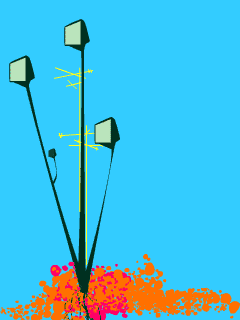State in Crisis:
Contemporary Argentinean Video Art
Selected by Jorge La Ferla, 60 minutes
This assemblage of Argentinean work presents the paradoxical situation
of access to and freedom of expression through independent media.
1. "Flight 101 : to no man’s land",
Diego Lascano,
5’ 43’’, 1992
Lascano uses the chroma-key in combination with characters in order to narrate the saga of contemporary Argentinean history. This wider and more ambitious objective of including an extensive spectrum of Argentinean history in his work, reveals one of the author’s passions as compiler of events. Through the possibility of alignment and manipulation of historical archives and their combination with other images, Lascano articulates a more distanced and complex reading of history than the lineal classicism of traditional documentary.
View the video
2. "Blue Print",
Claudio Caldini,
4’, 1993.
Following the customs of impressionist art, Caldini reconstructs nature through delayed video brush strokes, creating an electronic landscape that is gazed upon from outside the frame - the camera’s point of view and the character’s vision, of whom we only perceive a shadow. Light and time allow the viewer to explore a space which is no longer a still life, but rather alive, due to the sweeping of the video image. The piece was filmed in Super 8 and transferred to video after a meticulous reconstruction of the image. The fragmented structure of the shadow’s journey proposes a metonymical figure, whose intent is to artificially reconstruct the entirety of nature and of the character itself. Caldini manages to reformulate the expressive "Diegetic" sense of the use of the outside frame by means close-ups, and the deconstruction of space - as a re-composition of the present - which requires an active and diverse perception from the spectator.
View the video
3. "Filtrations",
Alejandro Sáenz,
11’17’’, 1999.
Although Sáenz has always formally experimented with the electronic image, "Filtrations" articulates a more materialized discourse, one that contains a deep structure elaborated in the post-production process. For him, the analog editing process has turned into extreme manipulation at a digital work-station, becoming a tool that allows him to reconstruct the narration of a confused and blurry remembrance of the past. The memory of a house is constructed by means of fragmented vision, which is slowly configured into multiple audiovisual layers, as rough, uneven and confusing neuronal synopsis’.
View the video
4. "Lost and found",
Arturo Marinho, 11’,
2000.
With "Lost and Found", Arturo Marinho manages to condense a search for a style which he has been researching for the past decade. Something happened somewhere - an airplane accident perhaps - of which only the ruins remain. In order to understand the path of some the characters in this piece, the ruins must be given a cohesive order.
View the video
5. "The Forest",
Florencia Acevedo,
5’, 2000.
In "The Forest," silence has a profound value for the staging of sound, becoming the impetus for the creation of this piece.
View the video
6. "Photographs",
Guadalupe Pérez García,
8’ 30’’, 2000.
Tourist landscapes from Saint Petersburg become an excuse to explore an intimate reading of a neighborhood in Buenos Aires. The dichotomy between the perverse intimacy of the audio and the tourist imagery of Saint Petersburg, is used by Pérez García to create a tension between the uneven, non-lineal flows of memory and desire. This subtle and interesting work proposes an interpretation in layers, which breaks any possibility of verisimilitude, referential and mimetic, between what is referred to verbally and what is seen on the screen.
7. "One afternoon",
Carlos Trilnik,
6’, 2000.
This video achieves a high level of concentration and aesthetic depth through the play and reading of nature, and the self-referenciality of the character and in his relationship with the landscape. A space which is no longer a landscape, but rather an emotional representation of the state of being.
View the video
8. "Product of an absence",
Lorena Salomé,
9’27’’, 2001.
False memories, true reconstructions, or what happened to Aunt Matilde. The originality of this video resides in the way in which Salomé manages to rearrange her memory vis-a-vis the character of the piece. Her use of fictional documentary, video files and fictional naratives, trigger a story of loss in the realm of representation. Only through the manipulation of the image and its after-effects, can the heart and the uncertainties of the memory, remember. The presence of these layered images and sounds - as a product of absence in the work of Salomé - become the only way to deal with the inevitable: death.
View the video
@ MOCA at California Plaza
Nov. 9, 11am -5pm
|


